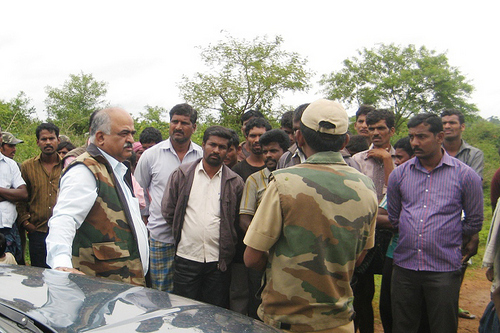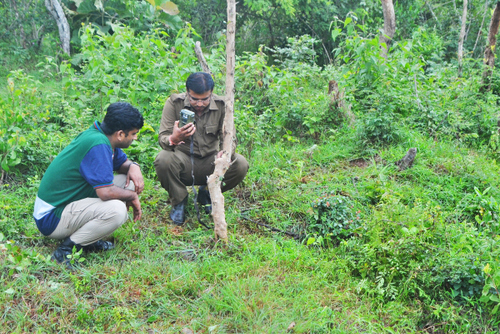Wildlife conservation can be harsh, unyielding and inexorable with little or no immediate returns. Yet, there are the few out there in the field who are equally resolute when it comes to their vow of protecting the country’s natural heritage … a story by Wildlife Trust of India’s Regional Head (South India), Jose Louies.
“This fellow is an extremely smart cat. He doesn’t walk overtly on open roads. He’ll silently move in bushes and suddenly come out to check the availability of potential prey outside the elephant proof trench. A swift jump across to make the kill, a quick bite and back it is to the safety of the forest cover. It’s not that easy to track this cunning tiger!” said Nagaraj Bhat, the experienced Field Officer of Wildlife Trust of India (WTI) who had suddenly found himself against a very clever feline who had a few villages and an entire Tiger Reserve’s administration at the edge of their seats.
To add to their woes, the monsoon was proving to be relentless and the rain showed no signs of stopping. Finding pug marks was becoming more difficult in the field and the young recruits of the frontline forest staff had been deputed across strategic locations to ensure that the tiger does not create any more havoc in the surrounding villages.
Welcome to Bandipur Tiger Reserve in the state of Karnataka in South India where the Care for Wild International-Wildlife Trust of India (CWI-WTI) team is currently assisting the State Forest Department in conflict-mitigation.
Bhat, a veteran field officer with more than two decades of experience in tracking large cats, was sought by the Department to assist the Special Tiger Protection Force team to help out with this case. For someone who knows the forest like the back of his hand, Bhat was finding himself pitched against an intelligent tiger who knew how to be elusive, almost toying with the team as he kept them on their toes trying to figure out his next move.

“We’ve been here for the last ten days, ensuring that the tiger stays within the forest boundary. The STPF team is ready at their strategic locations round the clock to ensure that the tiger doesn’t ‘stray’ into another village and pick up cattle. That will simply trigger retaliation from the villagers here. They can get very violent as we witnessed last year when an angry mob burned down our vehicles and an anti-poaching camp when we were dealing with another ‘conflict tiger’,” said one of the forest officers stationed at ground zero to monitor the situation.
Tiger conflicts aren’t a rare occurrence in the area and do tend to occur in the fringe villages as tigers stray out to lift cattle which is a very easy prey for these adept hunters. During this, if they happen to encounter humans, the tiger does attack and that is when conservation suddenly becomes a heavy burden for the forest officials to bear on their shoulders. The media is not always the biggest ally at that time and more often than not, graphic images of the attacks are strewn across local and national dailies, garnering little sympathy for the big cat which might have been defending himself. Politics is usually not far behind and the Forest Department staff literally finds themselves caught between the tiger and the crowd.
The rain had stopped for a little while and we decided to go check the camera traps. The road to the traps was caked in slush and the driver did the best he could to make sure that the tyres don’t get stuck in the mud. Almost as if it had been baiting us to be complacent and move, the rain Gods decided it was time for us to be in a downpour again.
Six camera-traps were checked and none of them had a tiger image in it. But there was something very interesting caught in one of the traps- two suspects cutting down trees. “This is another big problem here. These are not locals cutting down trees for firewood and subsistence but are mere smugglers here only for the commercially valuable trees such as teak and sandal. They sneak it out whenever possible and if they are attacked by a tiger in the forest, an area where they have no business entering, they of course contort the story to a desperate search for missing livestock. We’ve even had people claiming that the tiger hunted them outside the forest boundary, dragged them to the spot where you have the teak trees and left them there! No one will question the human’s story and every one will then be gunning for the tiger’s blood!” remarked Bhat with an obvious and extremely understandable misanthropic tone.
Finally, we managed to detect signs of the tiger in three locations- one was fresh scat on the road, another a scratch mark on the ground (looked fresh since the water puddle was still cloudy) and a mere hundred meters ahead of that, next to elephant proof trenches, pug marks of the tiger. I could see a farmer with his cattle just across the border, two hundred meters away from the trench. Now for a tiger, this lone farmer with his cow is simply an easy target. All he sees in the cow is meat that will last him for a few days and the man as an obstacle between him and his next meal.
I could see the STPF men on top of the hillock, keeping an eye on the ground below to alert the other teams if there is a tiger movement. These brave young men are really the backbone of tiger conservation and without them any kind of conflict management is quite impossible in the forests of India. Luckily for the farmer and the tiger, the latter had decided to let the former go scot-free.
We planned to reposition the camera traps in newly selected locations. I was in the field for a mitigation situation after a really long time and it was an opportunity for me to brush my skills. Bhat was kind enough to allow me to select a location, under his strict guidance of course! We set up four camera traps and moved backed to the base camp when the torrential downpour wouldn’t permit us to continue any further.
The wee hours of the next morning dawned on us with an image of a tiger in one of the relocated camera traps. The animal had been very close to the camera and the image was over exposed. As I write this, the identity of the tiger is being verified.

Since there were no more reports of cattle being lifted, part of the team was called back and yesterday evening I called Bhat who sounded more relaxed than I had heard him in over a week. To make himself heard over the rain, he shouted one simple line into the phone, “I will send you more updates once I have a decent bath and a goodnight’s sleep.”
I’m sure these sentiments would’ve been echoed by the STPF men as well who had spent ten straight days in the field. A hot water bath and a good night’s sleep can easily become an ill afforded luxury should the tiger decide to hunt down another cow.
Wildlife conservation is not as it may appear on the silver screen. There is little glamour involved when you stay in the ‘exotic’ forests. It is one of the toughest and most unpredictable jobs where when dealing with the elements of nature, capricious wild animals and an equally, if not more volatile, angry mob who may want to burn down the forest, destroy its wildlife and care little for those who stand in their way.